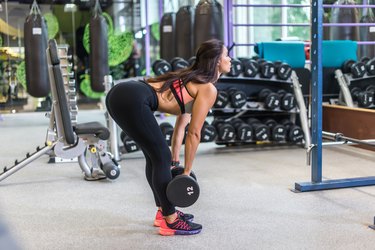
A lifted booty that fills out your jeans is a goal for many a fitness buff. Deadlifts are super versatile and effective at training your lower back, hamstrings and, of course, your butt.
To build a bigger butt, do your deadlifts using moderate to heavy weights. Heavy weights challenge your muscle fibers to break down, so they build up stronger and thicker to fill out your backside.
Video of the Day
Video of the Day
The deadlift may be done keeping your knees nearly straight or bending them entirely.
Before You Begin
The deadlift is an advanced exercise. Therefore, you should undertake a leg and lower back resistance training program for six to eight weeks prior to performing deadlifts with heavy weights. Your preparatory workouts should include barbell back squats, lunges, leg extensions, leg curls and back hyperextensions.
Once you begin incorporating deadlifts, make them the second exercise in your progression for your lower body, after only squats. After the deadlifts, add lunges or cable hip extensions to enhance your butt development.
Frequency, Intensity and Volume
The weight you lift must be heavy enough that you can complete only six to 12 repetitions for a maximum of six sets of deadlifts. This challenge helps to round and grow your gluteal muscles.
Perform your butt-building routine along with your thigh and calf exercises no more than two days per week to reduce your risk of overuse injuries.
Read More: My Lower Back is Tight After Deadlifts
Straight-leg Deadlift
Straight leg barbell dead-lifts engage your gluteal muscles more than bent-knee deadlifts. Deadlifts should be performed inside a squatting rack or on a deadlift-specific rack, when possible.
Position the barbell on the rack about three inches above your knees. You do not need the safety bars of the squat rack when you execute deadlifts. However, you should use safety collars to secure the weight plates on the barbell so they do not slide off to the side.
To perform this exercise: Stand at the center of the bar, with your hands shoulder-width apart and holding the bar with a mixed grip, meaning one is underhand and one overhand. Your thighs should be touching the barbell.
Stand up straight, using your legs to lift the barbell off the support pegs and step backward about two feet. Draw your navel toward your spine to maintain a flat back, then stick your buttocks out behind you as you lower the barbell toward your ankles. Keep a slight bend in your knees and look at the wall in front of you at a point slightly above the level of your eyes throughout the movement.
Contract your gluteal muscles to return to an upright position and pushing your hips slightly forward at the very end of the movement. Keep the barbell close to your body as you can with every repetition.
Bent-knee Deadlift
The bent-knee deadlift looks like you're squatting with a barbell against the front of your thighs. This variation targets your quads as well as your hips, buttocks and back. You can do the bent-knee deadlift from a rack or with a barbell on the floor.
To perform the exercise: Stand with your legs close to the barbell, holding the barbell with your hands shoulder-width apart and your palms in a mixed grip. Lift the barbell off of the support pegs and step back about two feet.
Keep the bar close to your legs as you stick your buttocks out behind you while simultaneously bending your knees until your thighs are nearly parallel to the floor or the weight plates touch the ground. Push through your heels and contract your glutes to stand back up. Pushing through your heels engages your gluteal muscles more than your quadriceps.
Read More: What are the Benefits of Deadlifting?